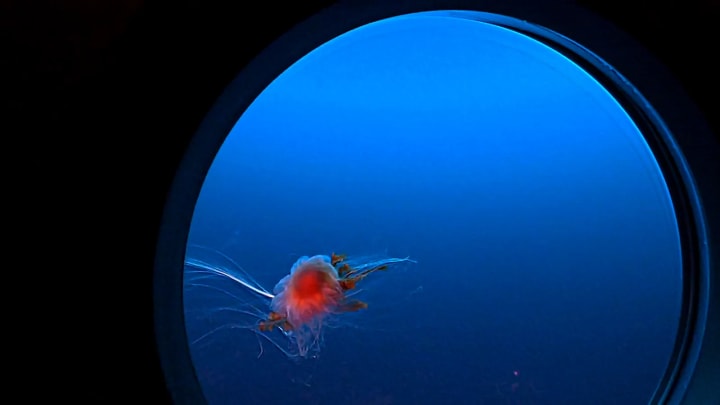A new mission to see Titanic
For many, seeing the world's most famous shipwreck is a lifelong dream. And now, paying adventurers called "mission specialists" can get the chance to explore Titanic up close.

Four-hundred miles from St Johns, Newfoundland, in the choppy waters of the North Atlantic Ocean, a large industrial vessel swayed from side to side. Onboard, Stockton Rush expressed a vision for the future:
"There will be a time when people will go to space for less cost and very regularly. I think the same thing is going to happen going under water."
Rush hopes that his company OceanGate will do for deep-sea exploration what innovators like Elon Musk, Richard Branson and Jeff Bezos are trying to do for space travel: allow anyone with enough money to venture to new worlds, even if they lack the specialist training.
Rush's location in the North Atlantic is unremarkable at first glance. However, it is here that one of the most renowned and tragic events in history took place: 3,800m below the surface lies the wreck of the Titanic, which sank in April 1912 after striking an iceberg on its maiden voyage.
"There are three words in the English language which are known throughout the planet. That's Coca-Cola, God and Titanic."
For Rush, who is trying to make deep-sea exploration for the masses commercially viable, the site of the world's most famous shipwreck was a "must-do dive". He added, "I read an article that said there are three words in the English language which are known throughout the planet. That's Coca-Cola, God and Titanic."
But to make his Titanic dream a reality, Rush has had to create a new type of submersible made of lightweight materials that could take up to five people down from the ocean vessel to Titanic's depth. Many thought it couldn't be done.
Now though, Rush was at the site (after successfully reaching the wreck in the submersible last year) with a large mix of people, including the crew aboard the vessel, OceanGate staff, scientists and a small but crucial group of paying adventurers called "mission specialists" who each paid up to $250,000 (about £225,000) for a chance to see Titanic up close.
While there, they would also have the chance to help as citizen scientists, gathering pictures and video of the deep-sea biodiversity.
This particular dive included banker Renata Rojas, businessman Oisin Fanning and television professional Jaden Pan, plus oceanographer Steve Ross and submersible pilot Scott Griffith.

Rojas explained, "I'm not a millionaire. I've been saving money for a long, long time. I made a lot of sacrifices in my life to be able to get to Titanic. I don't have a car, I didn't get married yet, I don't have children. And all those decisions were because I wanted to go to Titanic."
"I'm not a millionaire. I've been saving money for a long, long time. I made a lot of sacrifices in my life to be able to get to Titanic."
For Ross, these dives offer a rare chance to study the deep ocean environment by taking water samples around the wreck site and making a record of the biodiversity with his camera. He said, "There is sort of a race to understand the deep sea, which is the largest environment in the oceans and the most poorly explored. Changes in the ocean have a huge impact over the whole globe."
As the submersible descended for more than two hours to the bottom of the ocean with its passengers, onboard, Ross observed this biodiversity through the porthole window.

"On the way down, we saw mesopelagic animals [that are] involved in the largest migration on Earth. Every evening, this big community migrates to the surface, and each morning they migrate back down to 500 to 1,000m. A lot of those animals have bioluminescence, so you get flashes of light here and there."
When the submersible hit the ocean floor, it landed in the 15sq m debris field that surrounds Titanic's severed bow and stern.
"All five of us unofficially had this moment of silence," said Pan. "The first thing I see are pieces of coal. That's the moment that connected me to the humanness of the Titanic. The fact that people had shovelled this, had brought it onto the boat, and during the sinking, it just all spilled out."

From the other end of the submersible, Pan heard pilot Griffith say, "Oh no. We have a problem."
"When I'm thrusting forwards, one of the thrusters is thrusting backwards," Griffith explained. "Now all I can do is a 360." On the ocean vessel above, Rush considered remapping Griffith's controller. "It's not going to be easy", he told his fellow support crew.
"I thought, we're not going to make it!" Rojas said. "We're 300m from Titanic and all we can do is go in circles."
The solution which came to Rush was brilliantly simple: "Tell him to hold it the other way," he said. After establishing that turning left on the controller will move the submersible forwards, he concluded that turning the controller 90 degrees clockwise will make the submersible possible to go forward again.

Passing colourful tiles, plates and a sink in the debris field, they soon reached their goal: the bow of the Titanic – iconic from when romance blossomed between the fictional Jack and Rose in the movie Titanic. Selfies taken, the remaining hours on the ocean floor were spent exploring the rest of the bow and more of the debris field before ascending to the surface.
While the analysis of the data they collected (from the video) will take some months to complete, the mission was instantly gratifying. Soon after emerging from the submersible back on the ocean vessel, Rojas wiped away a tear, saying "I needed to do it to feel complete. I feel now complete."
About the Creator
Sweet Holdeman
I do not ask the heavens to be pleased with my beauty, but I hope that I will always be at liberty to do so.






Comments (1)
You have a very creative idea!